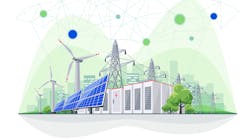Four Tenets for a Future-Forward Energy Strategy
As manufacturers adjust to the realities of the post-COVID-19 era, they have a unique opportunity to embrace sustainability to mitigate risk, improve energy efficiency in their operations and recession-proof their business.
Energy is the common denominator in achieving these three goals. Looking beyond just the type of energy used to power their plants, manufacturers now have the technology available to help determine how and when energy is used—benefiting their company, their customers and the planet.
Key tenets of an future-forward energy strategy include:
Reducing load and forecasting future demand – Facilities with heavy industrial equipment or large air conditioners that cycle on and off during the manufacturing process face steep demand charges that can account for more than 50% of utility bills. Technologies such as onsite battery storage that can charge during low-cost electricity periods and discharge when demand charges are highest or loads are greater can help control and ultimately reduce energy costs. Implementing solutions that enable facilities to forecast future demand charges also enable manufacturers to shift energy consumption to lower their bills. This provides the flexibility to make economic tradeoffs when determining how much energy to deploy or save for later, allowing manufacturers to proactively reduce peak charges and supplement when energy demand increases.
Automating energy savings while enhancing operational efficiency – Manufacturers have been on the frontlines of innovation from the perspective of automating and leveraging robotics to streamline processes. But these tools require power, which is a considerable expense and must be resilient to prevent operational disruptions. Instead of continuing with time-consuming, manual practices – like tracking time-of-use rates, operating during non-peak hours or manually curtailing energy use – manufacturers can leverage the power of AI to automate processes and lower utility bills. For example, AI can simplify the complexity of the energy market, digesting datasets – such as rate structures, solar production forecasts, demand, price signals and market participation rules.
Mitigating power interruptions by improving resilience – Certain parts of the country, including California, the Gulf Coast and Atlantic states, face severe weather events and natural disasters. And in some areas, grid reliability is a top concern. Each resulting outage or momentary blips due to poor quality power can cost facilities hundreds of thousands of dollars in downtime and potentially damage expensive equipment. To compensate, manufacturers have typically installed diesel generators as backup, but these can be costly to install and maintain, and cause downtime as they fire up when outages occur. In seeking alternatives for resilience, some plants have turned to a combination of solar and battery storage for back-up services. And, in the process, they're creating their own microgrids that can switch on to ensure business continuity if power interruptions occur.
Building brand loyalty through sustainability – In a challenging economy, adopting sustainable practices or new technologies may be a low priority. Yet, during this time brand loyalty becomes increasingly important. As manufacturers are looking at ways to retool supply chains and operations, they should take a long-term view of sustainability, and consider adopting environmental, social and corporate governance (ESG) programs that focus on clean energy and reducing carbon emissions. These efforts could include onsite or offsite solar generation, renewable energy procurement via power purchase agreements (PPAs) or other mechanisms, and electrification of vehicle fleets or other fossil-fueled equipment. Consumers and employees are more likely to look favorably on manufacturers that go the extra mile to address social and environmental concerns.
Even though manufacturers may have a hard time seeing the long view as they're addressing the firestorm of issues from COVID-19 and its resulting economic downturn, now is the time to build a foundation for a strong future. Energy solutions such as solar, wind power and battery storage coupled with AI can improve operational efficiency, make facilities more resilient to power outages, and help manufacturers become sustainability leaders.
As Chief Technology Officer for Stem, Inc., Larsh Johnson leads hardware and software engineering to meet the unique solar/energy/resilience needs of manufacturing companies--including Saint-Gobain, Alsco, Food Service Partners, Kieran Label Corporation, Reliance Metalcenter, Royal Philips Electronics N.V., ShoEi Foods, and more. Prior to joining Stem, he was CTO at Siemens Digital Grid. He was also a founding member of the Department of Energy’s Gridwise Architecture Council (GWAC) and remains a member emeritus. He earned his B.S. and an M.S. in mechanical engineering from Stanford University.




